Exploring Honey Bees: Anatomy and Appearance Insights
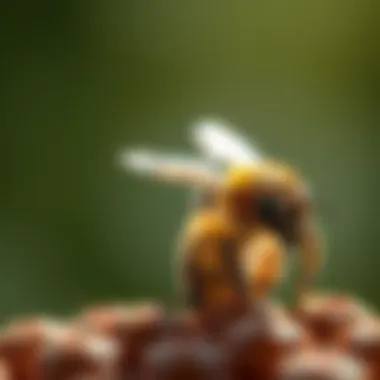
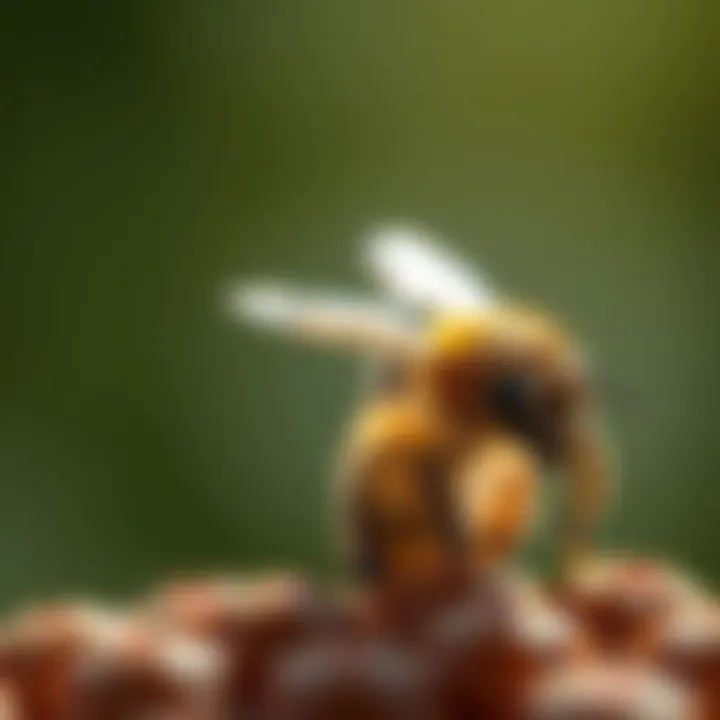
Intro
Honey bees, often seen flitting from flower to flower with their signature buzz, are not just a delightful sight in gardens and orchards; they are vital stakeholders in our ecosystem. Understanding what goes into the making of a honey bee—its appearance and anatomy—is crucial for grasping how these insects affect pollination and, subsequently, food production. In this article, we will take you through a comprehensive analysis of the external features and internal systems that define honey bees, from their coloration to their body structure, family dynamics, and development stages.
Research Overview
By shining a light on the anatomical aspects of honey bees, we can better appreciate their role in agriculture and biodiversity. This exploration looks at how the honey bee's physical traits are not only beautiful but serve specific functions that enhance their survival and efficiency as pollinators. Here, we lay the groundwork based on key findings that underscore the importance of these bees and detail the methodology used in studying their anatomy.
Summary of Key Findings
- Physical Traits: Honey bees present a striking variety in color, predominantly in shades of yellow and black, which may serve as an indication of their individual species and their roles within the hive.
- Body Structure: The unique structure of honey bees, comprising three main body parts—the head, thorax, and abdomen—allows for complex behaviors like foraging and communication.
- Adaptations: Special features, such as specialized mouthparts for feeding on nectar and legs designed for pollen collection, cater to their lifestyle as efficient pollinators.
Significance of Research
Understanding the anatomy of honey bees fosters appreciation for these creatures and, consequently, the ecosystems they support. As honey bee populations face unprecedented challenges like habitat loss and pesticide exposure, knowledge of their anatomy can contribute to conservation efforts and sustainable practices in agriculture.
Methodology
With a comprehensive review of the physical and anatomical features of honey bees, it’s essential to consider the approaches taken to gather this information. The following outlines the research design and the methods employed for data collection.
Research Design
The approach adopted for this research includes both observation in natural habitats and laboratory analysis of specimens. This dual approach allows for a thorough examination of bees in their environments, as well as a controlled study of their anatomical structures.
Data Collection Methods
- Field Studies: Observations in varied ecological niches to account for diversity in honey bee species.
- Morphological Analysis: Dissection of specimens to study internal anatomy and collect data on specific structures.
- Documentation: Utilizing photography and detailed notes to catalogue different traits noted during observations.
Through this structured methodology, we obtain a richer understanding of honey bees and their critical role in maintaining ecological balance. This basis will help inform further discussions on their anatomy later in the article.
Preamble to Honey Bees
Understanding honey bees is crucial for comprehending their vital role in both our ecosystems and agricultural systems. Not just simple insects buzzing around, honey bees are complex creatures whose lives and behaviors impact hundreds of thousands of other species in various ways. This article seeks to unravel the intricate details of their appearance and anatomy, shedding light on the many layers of their existence.
For individuals studying ecology or those merely curious about nature, the honey bee serves as a fundamental subject. They hold significance not only in the ecological balance but also in food production. Hence, investigating their characteristics can illuminate how they contribute to pollination. By recognizing the complexities of their anatomy, we can better understand their strengths and vulnerabilities in an ever-changing environment, making this topic all the more essential.
Overview of Honey Bee Species
There are numerous species of honey bees, with Apis mellifera being the most widely known and studied. This species, often simply called the Western honey bee, is renowned for its honey production and role in pollination. Other notable species include Apis cerana, the Asian honey bee, which has adapted to diverse environments across Asia and has different behaviors and body size compared to A. mellifera.
In total, there are around 7 recognized species of honey bees, each exhibiting unique adaptations. From the docile temper of the Italian honey bee to the resilient nature of the Carniolan honey bee, their diversity reflects distinct behavioral traits and habitat preferences. The exploration of these variations in species is not only fascinating but essential for better beekeeping practices and conservation efforts.
Importance of Honey Bees in Ecosystems
Honey bees are unparalleled in their contribution to pollination, acting as a linchpin in many ecosystems. They affect a plethora of flowering plants, which in turn support various other organisms by maintaining the food chain. Estimates suggest that nearly 35% of global crops rely on bee pollination, which translates to about $15 billion in added agricultural production annually in the United States alone.
"Without honey bees, our food system would be severely compromised. Their role as pollinators is irreplaceable."
The ecological balance maintained by honey bees fosters genetic diversity in plants, which is essential for resilience against diseases and environmental changes. The absence of honey bees could lead to the decline of many species, adding significant pressure to already strained ecosystems.
In summary, honey bees are not only vital for their ecological functions but also for their economic importance in agriculture. Understanding their anatomical features and variations is key to appreciating their role and significance in the broader context of our environment.
General Physical Characteristics
The physical characteristics of honey bees are fundamental to understanding their behavior, roles in ecosystems, and how they interact with their environment. This section focuses on the anatomy and size variations across different types of honey bees, serving as a foundation for grasping how these traits contribute to their survival and efficiency as pollinators. Through exploring their body structure, we can appreciate the adaptations that allow them to thrive in diverse habitats and fulfill their roles in food production.
Body Structure Description
Honey bees possess a distinct body structure divided into three primary segments: the head, thorax, and abdomen. Their head contains key sensory organs including compound eyes, which allow them to detect light and movement, and antennae that serve as vital sensory appendages, helping them navigate their environment while locating food. The mouthparts are adapted for both sucking nectar and collecting pollen, showcasing their versatility.
Moving down, the thorax is equipped with three pairs of legs, which are crucial not just for locomotion, but also for transporting pollen back to the hive. Each leg has specialized structures, like pollen baskets on the hind legs, known as corbiculae. The thorax also houses the wings, which are essential for flight, enabling bees to travel significant distances in search of nectar and pollen.
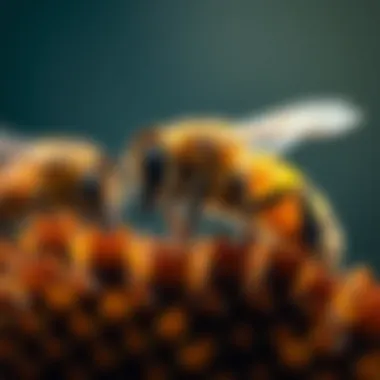

Finally, the abdomen is elongated and houses vital organs for digestion and reproduction. It’s also where the famous stinger is located, which serves both defensive and reproductive purposes. This clear segmentation not only defines the honey bee's anatomy but directly influences its behavioral patterns and ecological roles.
Size Variations Among Different Types
Honey bees exhibit notable size variations that can be tied to their subspecies and functional roles. The common Western honey bee, Apis mellifera, typically ranges from 1.5 to 2.0 cm in length. However, variations do exist within some subspecies. For instance, the Italian honey bee is generally larger than its Carniolan counterpart, which is somewhat smaller and more slender.
- Queen Bees: The queens are the largest of the colony, measuring around 2.5 cm. Their size allows them to lay thousands of eggs, which is pivotal for colony sustainability.
- Worker Bees: Workers are more medium-sized, average 1.2 to 1.8 cm, and are adapted for various tasks such as foraging and nursing the brood.
- Drones: Drones, the male bees, are larger than workers, about 1.5 to 2.0 cm. They have larger eyes, which help in spotting queens during mating flights.
Such variations in size are not just a matter of aesthetics; they reflect specialized roles within the hive’s hierarchy, which contributes to the colony’s overall efficiency.
Comparison with Other Insects
When discussing honey bee characteristics, comparing them with other insects can illuminate their unique features. Unlike many insects with a segmented body and rigid structure, honey bees have a flexible exoskeleton composed of chitin that aids in movement. This flexibility allows honey bees to perform intricate maneuvers while foraging or evading predators.
Comparatively, ants and flies share a fundamental body plan with honey bees but differ significantly in their functional adaptations:
- Ants: Sometimes confused due to their social structure, ants lack wings and show a different way of communicating and working as a colony. Their determinacy for terrestrial life distinguishes them from bee behavior.
- Flies: While flies have large eyes and are adept fliers, they lack the specialized mouthparts honey bees use to extract nectar, showcasing a divergence in feeding strategies.
"Understanding how honey bees differ from their insect cousins can reveal much about their ecological importance and evolutionary adaptations."
In summary, the general physical characteristics of honey bees not only highlight their structure but also emphasize their vital roles in the ecosystem. Age-old adaptations within their physical traits enable them to fulfill essential functions, impacting both the environment and agricultural productivity.
Coloration and Patterns
Understanding the coloration and patterns of honey bees is a vital aspect of their biology that plays an important role in their survival and interaction with their surroundings. Coloration helps with species identification, enhances communication among bees, and can contribute to their defense mechanisms. Through a closer look at the typical coloration and the significance of these patterns, we can gain insight into the sophisticated adaptations that honey bees have developed over time.
Typical Coloration of Honey Bees
Honey bees typically exhibit a range of colors, predominantly shades of yellow and black, which can vary significantly between species and subspecies. The general appearance is characterized by distinct banding patterns; for instance, the European honey bee (Apis mellifera) is known for its alternating yellow and black bands. In contrast, the Carniolan honey bee (Apis mellifera carnica) tends to have a more muted coloration with grayish undertones.
This variation in color is not just a matter of aesthetics. The pigmentation in honey bees is influenced by their genetic makeup, and the colors can also reflect their adaptation to different environments. For example, bees found in sunnier areas may exhibit brighter coloring that can assist in thermoregulation, while those in shaded, cooler climates often take on darker hues, aiding in heat absorption.
"The exhibition of color is not a mere accident of evolutionary history; it is a finely tuned adaptation to an ever-changing environment."
Significance of Color Patterns
The patterns exhibited by honey bees extend beyond mere visual appeal; they serve multiple ecological functions. One of the primary roles of these color patterns is communication. When bees forage, their coloration can attract both fellow bees and potential flowers, playing a crucial role in pollination. Bright patterns make the foraging honey bee more discernible among the flora, guiding other bees to food sources and nurturing a sense of community.
Additionally, color patterns can be essential for mating. Many male bees are drawn to specific colorations during courtship, where brighter colors might signal health and vitality. Thus, one could argue that color plays a pivotal role in ensuring genetic diversity within bee populations.
Moreover, coloration can be a defense mechanism against predators. Certain honey bee species may display a darker coloration to mimic the appearance of more dangerous insects, thereby discouraging potential threats. This phenomenon of Batesian mimicry can deter birds or other predators from attempting to prey on them.
Anatomical Features
Understanding the anatomical features of honey bees is crucial for grasping how they function within their environment. The various parts of their anatomy play vital roles not just in individual survival, but also in the overall health of the ecosystem. From their head structure, which houses sensory organs, to the thorax that facilitates movement, and the abdomen that serves multiple functions, each segment carries its weight in the daily lives of these industrious insects.
Head Structure
The head of the honey bee is a complex structure, pivotal for navigation and communication. It features a pair of large compound eyes that can detect motion and light effectively, allowing bees to orient themselves during foraging. The simple eyes, or ocelli, are also embedded in the head, contributing to their ability to sense light intensity.
The mandibles, or jaws, lie on either side of the head. These are not only designed for tearing food but are crucial in wax production as well. The way these mandibles work is quite intriguing; they effectively facilitate the construction of wax cells within the hive.
Moreover, the antennae, which might be overlooked, serve as the bees’ primary sensory input—analysing smells, tastes, and even humidity levels. This sensory capability is fundamental for locating flowers and identifying the quality of nectar.
Thorax Anatomy
Moving down from the head, the thorax is a powerhouse—a muscular section responsible for locomotion. The thorax consists of three segments, thought each one articulates perfectly with the legs and wings. Each of these legs enables the bee to perform distinct tasks like collecting pollen or gripping onto surfaces to maintain stability.
Furthermore, the wings, which are uniquely developed for flight, can be unhooked or hooked depending on their use, thanks to a special joint. This gives honey bees remarkable agility in the air, necessary for dodging predators or navigating tight floral passages.
Interestingly, bee species can have variations in wing structure that correspond to their foraging habits. For instance, worker bees generally possess longer wings compared to drones, which can limit flight efficiency.
Abdominal Characteristics
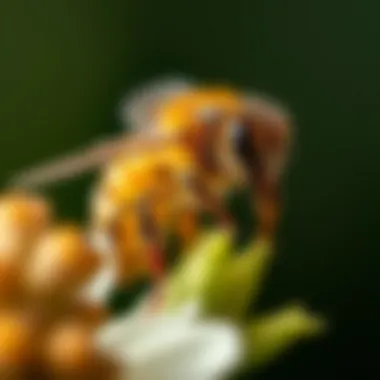
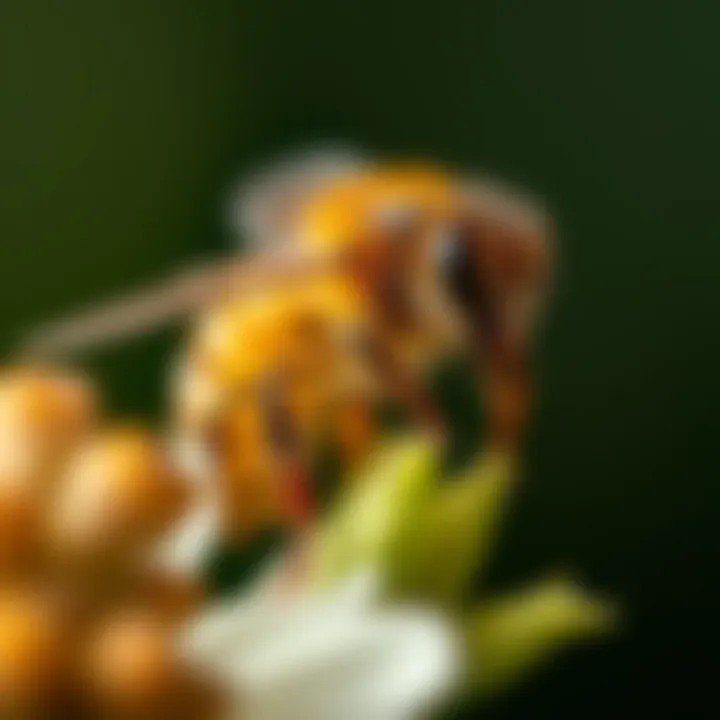
The abdomen represents a multifunctional part of a honey bee's anatomy. It is home to the reproductive organs in queens, and also contains the stinger for defense. Interestingly, the stinger is a modified ovipositor used for laying eggs, evolving over time to serve defensive purposes against threats.
Within the abdomen, there lies a digestive system that processes nectar into honey, showcasing a remarkable adaptation for nutrient storage. The honey stomach, distinct from the main digestive tract, allows bees to transport nectar back to the hive.
Additionally, the coloration and segment patterns of the abdomen can also vary widely among species. This not only has aesthetic implications but often aids in the identification of species and subspecies.
Quote: "The intricate anatomy of honey bees is a testament to evolutionary adaptations that enhance their survival and ecological roles."
In summary, the anatomical features of honey bees illustrate a fine-tuned system of coordination and functionality. Each part of their bodies plays a critical role in ensuring these pollinators thrive, making it essential to recognize how their anatomical structure lays the groundwork for their important ecological contributions.
Developmental Stages of Honey Bees
The developmental stages of honey bees are crucial in understanding their life cycle and ecological contributions. This section sheds light on how these stages are not merely phases but represent significant transformations that determine the fate of the colony. By studying these stages, we can appreciate the complexities and intricacies of honey bee life, which plays a pivotal role in their survival and efficiency as pollinators. Understanding the developmental phases—from eggs to larvae through to adulthood—provides valuable insights into how colony dynamics function and why maintaining healthy hive conditions is paramount.
Egg to Larva Transformation
The journey of a honey bee begins as an egg, a minute ovum laid in a cell of the hive. The queen bee lays hundreds of eggs, all with the potential to become new bees, depending on what happens next. After about three days, the egg hatches into a larva, which is a soft, grub-like creature.
During this larval stage, bees are quite vulnerable, relying heavily on the care provided by the worker bees. The larvae are fed a protein-rich substance called royal jelly for the first few days of their lives, and then they switch to a diet of bee bread, which is a mix of pollen and honey. This diet choice plays a significant role in determining the future role of the bee.
In this phase, several remarkable changes occur:
- Growth Rate: The larvae grow incredibly fast, almost doubling in size every day. This rapid growth requires substantial nutrition and active care from the worker bees.
- Morphological Development: As they grow, larvae go through several molts, shedding their skin to accommodate their increasing size. This ability to change physically illustrates their adaptability as they prepare for the next phase of life.
- Environmental Sensitivity: The conditions surrounding them—like temperature and humidity—are critical during this stage. Worker bees regulate the hive's environment to ensure optimal growth, highlighting the hive’s communal effort in supporting each new life.
Once the larvae reach mature size, they enter the next stage, the pupal stage, after they are sealed in their cells. This transition marks a significant evolution in their anatomical structure, preparing them for their eventual emergence as adult bees.
Pupa to Adult Changes
After the larval stage, which can last from five to ten days depending on various factors, the honey bee undergoes yet another fascinating transformation: the pupal stage. In this phase, the larva develops a protective cocoon and undergoes several internal and external changes that are nothing short of miraculous.
- Metamorphosis: This stage is characterized by complete metamorphosis. The larva is restructured into a fully formed adult bee. Organs and body systems are arranged and altered, in a process that can take up to two weeks.
- Color and Form: The pupa initially appears white and resembles a larva, but gradually it starts to develop the dark exoskeleton that distinguishes adult bees. By the end of this stage, the physical characteristics such as wings, legs, and antennae become visibly defined.
- Preparation for Emergence: As the pupa develops, the cocoon remains sealed. Worker bees often prepare the environment; they maintain temperature stability in the hive, allowing for proper metamorphosis. When the time is right, the adult bee will puncture the cell cap and emerge into the world, ready to take on its role in the colony.
A single honey bee’s life is just a thread in the larger tapestry of bee ecology. The transformations from egg to larva to pupa and finally to adult, highlight the resilience and adaptability of these creatures.
"In nature, nothing stands still, and the transformation of honey bees from one life stage to another epitomizes this extraordinary dynamism."
Understanding these developmental stages not only enhances our appreciation for honey bees but also informs conservation strategies and bee management practices worldwide.
For more in-depth information, consider visiting Britannica or Wikipedia, which provide valuable insights into the ecology and biology of honey bees.
Behavioral Manifestations of Appearance
The way honey bees present themselves physically is not just for show; it fundamentally influences their interactions with the environment and other species, including humans. Honey bees possess unique traits that reflect their roles as pollinators and defenders of the hive. Understanding these manifestations can shed light on broader ecological dynamics and aid in the conservation of these essential insects.
Key elements that underpin the behavioral manifestations of honey bee appearance include:
- Recognition and Communication: Honey bees utilize their colors and patterns to communicate within their colonies. The distinct markings help workers identify their own queen and recognize other members of the hive. This recognition is crucial for maintaining colony organization and efficiency.
- Foraging Efficiency: The physical form of honey bees enables them to gather nectar and pollen effectively. Their hairy bodies not only trap pollen grains but also play an important role in the bees’ ability to navigate between flowers, ensuring successful pollination.
- Defense Mechanisms: Honey bees are equipped with certain traits that inform their defense strategies. The size and coloration can serve as warning signals to potential predators, while their stinger, a prominent feature, acts as a last resort for defense should intruders venture too close to their hives.
Overall, honey bee appearances go beyond mere aesthetics; they have practical implications that directly affect their survival and the health of ecosystems.
Foraging and Nectar Collection
Foraging is one of the primary behaviors in honey bee colonies, and their appearance plays a vital role in this activity. When honey bees embark on their nectar-collecting missions, they exhibit a combination of physical traits that allows them to excel.
- Body Shape and Size: The bulbous, rounded abdomen provides the necessary storage space for nectar while being aerodynamically shaped for quick movement. A typical worker bee can carry about half its body weight in nectar.
- Hairy Bodies: The fine hairs covering the bee's body help in capturing pollen grains. As they visit flowers, these hairs collect pollen as bees move from one bloom to another, effectively turning them into natural pollinators as they travel. This species of bees plays an integral part in the lifecycle of many plants, facilitating reproduction and eventual seed production.
- Coloration: Bees are generally drawn to brightly colored flowers that signal the presence of nectar. Their vision, which is sensitive to ultraviolet light, enables them to perceive color patterns that are invisible to the human eye. Therefore, the physical ability to detect and adapt to different colors of flowers enhances their foraging success.
Defense Mechanisms and Their Appearance
Honey bees face numerous threats from predators and environmental hazards. Their physical traits have evolved not only for survival but also as part of their defensive strategy.
- Stingers: One iconic feature of honey bees is their stingers, which are equipped with barbs. When a bee stings, it releases a venom that can deter various threats. The presence of the stinger sends a clear message: getting too close might hurt.
- Color and Size as Warnings: The coloration of honey bees acts as a warning signal to predators. Certain color patterns may indicate that a bee is capable of stinging, helping to deter potential attackers before they even get close. Larger bees, for instance, can appear more intimidating, which may reduce encounters with would-be predators.
- Swarming Behavior: When threatened, bees can resort to swarming as a defensive strategy. During this, worker bees cluster around the queen in a tight formation. This can be disorienting to predators and showcases the collective power of the colony. Such an appearance—the vast number of bees working as one—presents a formidable barrier for those who dare provoke them.
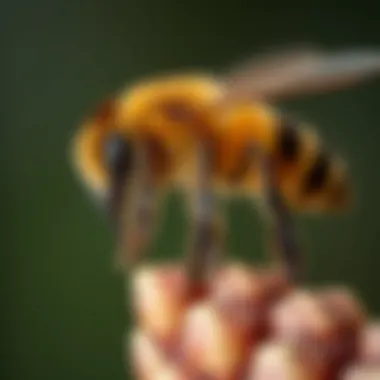

In summary, the various methods by which honey bees adapt their appearance reinforce their ability to thrive in their habitats. Their foraging strategies and defense mechanisms reveal a complex relationship between their physical characteristics and the roles they play in our world's ecosystems.
Honey Bee Morphology Across Species
Understanding the variability in honey bee morphology across different species is crucial for grasping how these insects function and thrive in various ecosystems. Differences in anatomy are not mere curiosities. They show adaptations that allow honey bees to optimize foraging, nesting, and reproduction in their respective environments. Recognizing these distinctions not only enriches our comprehension of honey bees but also sheds light on their role in pollination and biodiversity.
Differences Between Subspecies
Honey bees are remarkable creatures, exhibiting a variety of physical traits depending on their subspecies. For example, the Italian honey bee (Apis mellifera ligustica) is known for its golden coloration and docile nature, making it a favorite for beekeepers. In contrast, the Carniolan honey bee (Apis mellifera carnica) has darker coloration and a more robust body, allowing it to endure colder climates. Each subspecies has evolved specific adaptations:
- Size: Some, like the Buckfast bee, are larger and robust, while others remain smaller, affecting their foraging efficiency.
- Coloration: Variation in coloration often influences camouflage in local flora. A species with lighter coloring might be more adept at blending in with certain flowers, thereby enhancing its pollination efficiency.
- Social Behavior: Behavioral traits, like swarming tendencies or hive defense mechanisms, differ among subspecies as well. Some are more aggressive, suited for environments where predation is a significant risk.
These differences underscore how subspecies adapt to their environments, ensuring their survival and productivity.
Regional Variations and Adaptations
The morphology of honey bees does not just vary by subspecies; geographical factors heavily influence their physical traits. For instance, honey bees in warmer climates may have evolved to have larger, more spaced-out body structures to mitigate heat, while those in northern regions might exhibit compact shapes that conserve warmth.
- Altitude: Queen bees in mountainous regions often develop differently, with certain morphologies that help in mating flights at higher altitudes.
- Floral Availability: In areas where specific flowers dominate, honey bees may adapt their body structures and mouthparts to efficiently access nectar and pollen. This specialized adaptation ensures that they are well-suited for the available resources.
- Predation Pressures: In regions where predatory insects are prevalent, honey bees may develop increased body armor or altered behaviors, which fortify hive defensiveness.
"Studying regional adaptations allows researchers to appreciate the evolutionary pressures that shape the morphology of honey bees."
Overall, these adaptations reflect flexibility in honey bee morphology, allowing them to thrive in diverse environments. This understanding aids in conservation efforts, making it possible for beekeepers and ecologists alike to appreciate the intricate connections between morphology, behavior, and ecological health.
For further reading on honey bee adaptations, consider visiting resources like Britannica, or check local university studies on bee morphology.
Honey Bees in Context
The context in which honey bees operate extends far beyond their immediate environment. Their significance in ecosystems and agriculture cannot be overstated. As pollinators, honey bees play a pivotal role, not just in honey production but also in the reproduction of a vast number of flowering plants. This section delves into how honey bees interact with the environment around them, highlighting their connections, and the implications these relationships have on both the bees and the ecological systems in which they reside.
Honey Bees and Their Environment
Honey bees thrive in diverse habitats, from rolling meadows to verdant gardens and agricultural fields. Their adaptability is one of the reasons they are found in such varied environments. Here are some pivotal points regarding their ecological interactions:
- Floral Dependence: The survival of honey bees is inextricably linked to the availability of flowers, as they rely on nectar and pollen as primary food sources. Optimal bloom periods in their environment are critical for sustaining healthy colonies.
- Pest Control: By pollinating plants, honey bees inadvertently help control pest populations. When plants are healthy and reproduce successfully, they are less susceptible to pest infestations.
- Biodiversity Support: As they pollinate, honey bees contribute significantly to maintaining biodiversity. Many plants that are essential to other wildlife depend on pollination to reproduce.
Given their ecological roles, honey bees serve not only as a food source for numerous species but also as indicators of environmental health.
Impact of Climate on Honey Bee Appearance
Climate conditions play a vital role in shaping the physical characteristics and behavior of honey bees. Here are a few aspects in which climate affects their appearance:
- Coat Variation: Regional climate can influence the density and coloration of their bristle-like hairs, known as setae. In warmer climates, bees may have lighter, sparser coats compared to their counterparts in cooler regions. This adaptation helps regulate body temperature and aids in insulation during colder months.
- Size Adaptation: Some studies suggest that honey bee populations in harsher climates tend to be larger than those in moderate environments, a phenomenon known as Bergmann's Rule. Larger bees have a greater body mass which helps them retain heat better during cold spells.
- Phenology Changes: Climate change alters flowering times, which in turn impacts foraging behavior and nutritional availability for honey bees. If flowering occurs too early or late, bees may struggle to adapt, affecting their size and overall health.
"Climate not only influences the ecological interactions of honey bees but also their physical makeup, resulting in considerable diversity across regions."
Ending
The conclusion of this article encapsulates the essence of honey bee appearance, highlighting their crucial role both in their ecosystems and the broader environmental canvas. Understanding the unique characteristics of honey bees is not just an academic endeavor; it has real-world implications.
Summarizing Honey Bee Appearance
Honey bees exhibit a remarkable diversity in appearance that is intricately linked to their function within the hive and the environment. Their bodies, segmented into three primary sections—the head, thorax, and abdomen—are well-designed for efficiency and specialization. The head is armed with antennae that are vital for sensing the environment, while the thorax bears the strong wings and legs that facilitate foraging and hive maintenance.
By examining their coloration, we find that honey bees can range from deep black to lighter golden hues, each with specific adaptations to their local habitats. These color patterns do not only serve aesthetic purposes but have evolved as protection against predators and as a signal to other bees. For instance, darker bees may absorb more heat, thus thriving in cooler climates, whereas lighter shades may reflect the sun, helping in hotter environments. It's a fascinating interplay between their anatomy and the demands of their surroundings.
Notably, the societal behavior of honey bees also shapes their external appearance. Their physical traits, including size variations among castes like workers, drones, and queens, demonstrate a high level of specialization that optimizes colony efficiency.
Future Research Directions
Looking ahead, there's a wealth of untapped research potential concerning honey bees' morphological changes and the influence of climate change. Studies could examine how shifting temperatures and altered ecosystems impact bee coloration and size, as these factors are crucial for their survival and reproduction. It may also be beneficial to delve deeper into studying subspecies variations across different regions, paying particular attention to how these adaptations play a role in their resilience against diseases and environmental stressors.
Furthermore, there's a growing need for research that addresses the impact of pesticides and pollutants on honey bee physiology. Investigating these factors could reveal critical information on how appearance correlates with health and adaptability.
"The honey bee is proof that the smallest creatures can have profound impacts on the world around them."
For more scientific insights, visit resources on honey bee morphology from Wikipedia or explore ecological studies available through Britannica. Interested in community discussions? Check out forums on Reddit.
As we continue our quest to understand these remarkable insects, we find that every detail contributes to a larger narrative about life, resilience, and interconnectedness in our ecosystem.



